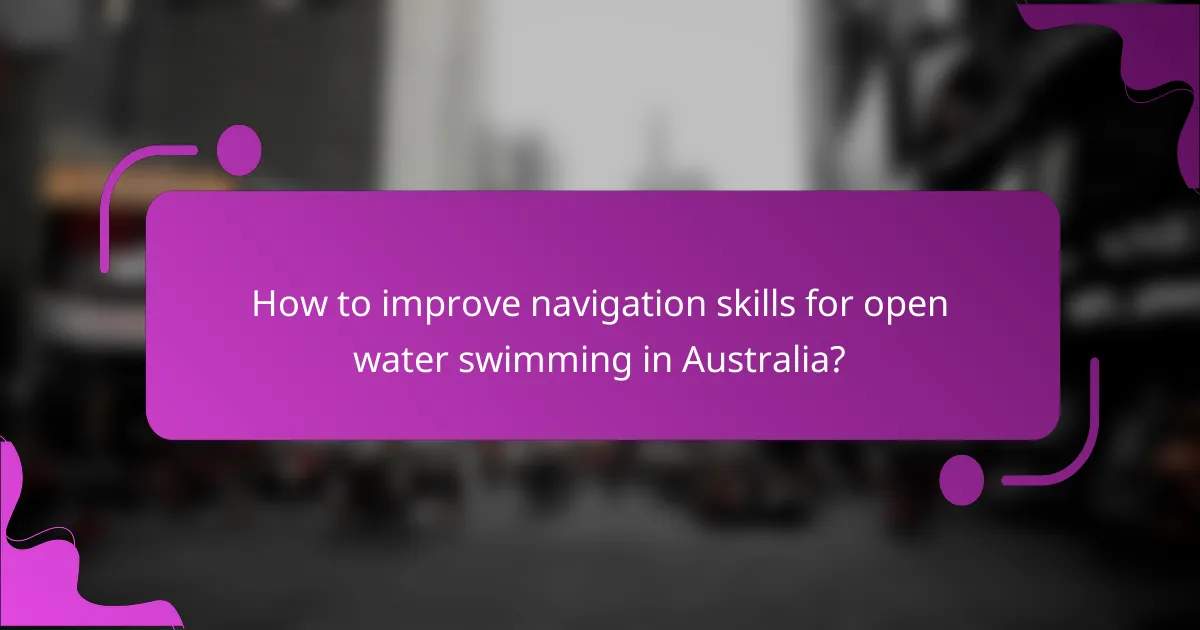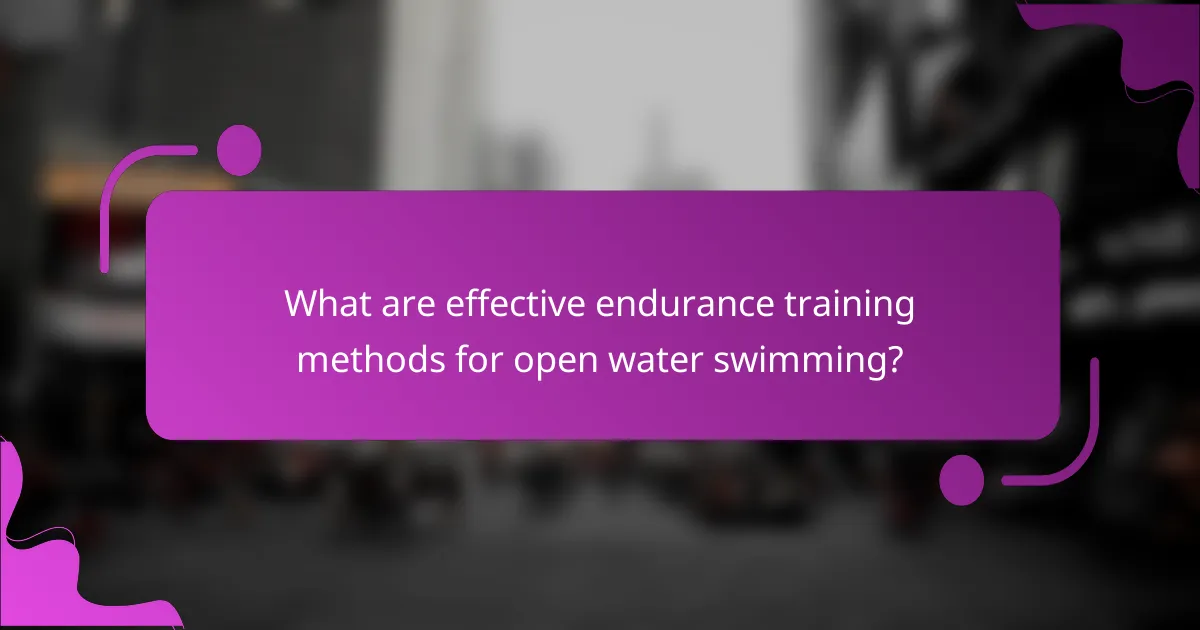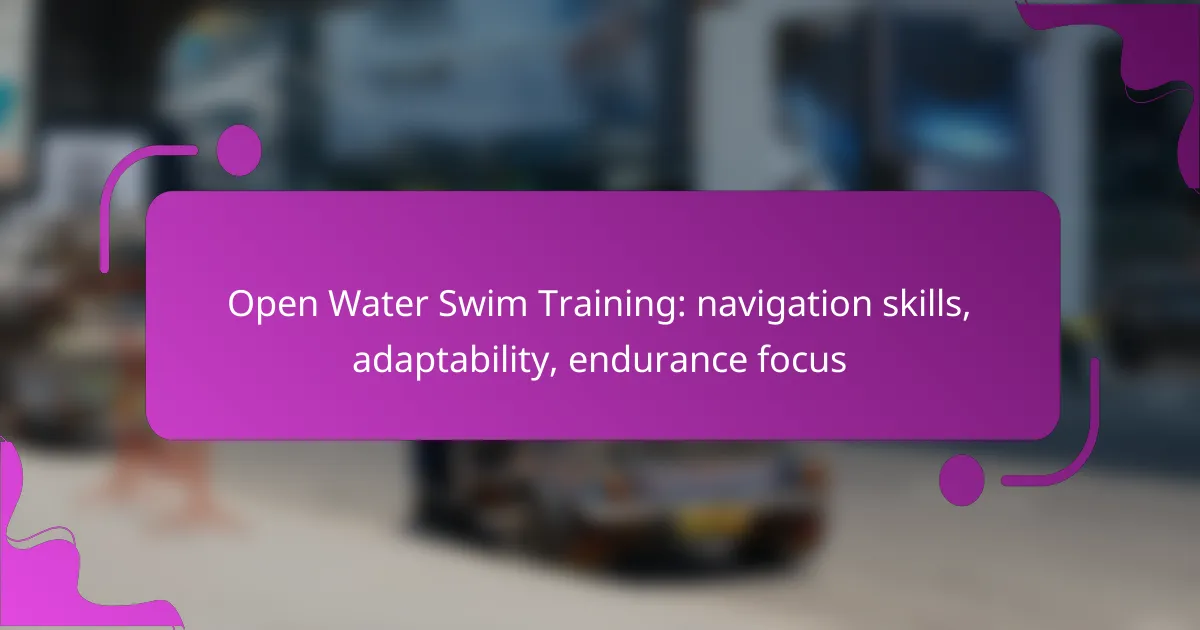Open water swim training is essential for enhancing navigation skills, adaptability, and endurance. By mastering techniques such as sighting and using buoys as references, swimmers can improve their ability to stay on course. Additionally, effective endurance training methods that include long-distance swims and interval training help build stamina while preparing swimmers for the unpredictable conditions of open water environments.

How to improve navigation skills for open water swimming in Australia?
Improving navigation skills for open water swimming in Australia involves mastering techniques that enhance your ability to stay on course. Key strategies include practicing sighting, using buoys for reference, and engaging with local swim communities.
Use sighting techniques
Sighting techniques are essential for maintaining a straight line while swimming. This involves periodically lifting your head to spot a landmark or buoy ahead, ensuring you stay oriented. Aim to sight every 6 to 10 strokes, adjusting based on your comfort and the water conditions.
To practice, choose a visible landmark on land, such as a tree or building, and swim towards it while periodically checking your direction. This will help you develop a rhythm and improve your overall navigation skills.
Practice with buoys
Practicing with buoys can significantly enhance your navigation abilities. Set up a course with buoys at various distances and angles, simulating race conditions. Swim from one buoy to another, focusing on maintaining a straight line and adjusting your sighting as needed.
Consider joining local events or training sessions that incorporate buoy practice. This not only builds your skills but also familiarizes you with the buoy placements typically used in Australian open water swims.
Join local swim clubs
Joining local swim clubs is an excellent way to improve your navigation skills. Clubs often organize group swims in open water, providing opportunities to practice in a supportive environment. You’ll also benefit from shared tips and techniques from experienced swimmers.
Look for clubs that focus on open water training and participate in local competitions. Engaging with fellow swimmers can enhance your skills and boost your confidence in navigating open water.
Utilize GPS devices
GPS devices can be valuable tools for tracking your route and improving navigation skills. Many swimmers use waterproof GPS watches to monitor their distance and pace while swimming. This data can help you analyze your performance and adjust your navigation strategies accordingly.
When selecting a GPS device, consider features like accuracy, battery life, and ease of use in water. Some devices even offer route mapping, which can help you visualize your swimming patterns and identify areas for improvement.
Attend open water clinics
Attending open water clinics can provide focused instruction on navigation skills. These clinics often cover essential techniques, safety protocols, and tips for swimming in various conditions. Participating in hands-on sessions with experienced coaches can significantly enhance your skills.
Look for clinics offered by local swim organizations or community centers. They typically cater to different skill levels and can help you refine your navigation abilities while connecting with other swimmers.

What are effective endurance training methods for open water swimming?
Effective endurance training methods for open water swimming focus on building stamina, improving navigation skills, and enhancing adaptability to varying conditions. Incorporating a mix of long-distance swims, interval training, cross-training activities, and structured plans can significantly boost performance in open water environments.
Incorporate long-distance swims
Long-distance swims are essential for developing endurance in open water swimming. Aim for sessions that last from one to three hours, depending on your fitness level and goals. These swims help your body adapt to prolonged exertion and improve your mental resilience.
When planning long-distance swims, choose varied routes that mimic race conditions, including currents and waves. This practice prepares you for the unpredictability of open water events.
Use interval training
Interval training enhances speed and aerobic capacity, crucial for open water swimming. Incorporate sets of high-intensity efforts followed by rest or low-intensity periods. For example, swim 100 meters at a fast pace, then rest for 30 seconds, and repeat this for several sets.
Intervals can be tailored to your specific needs, focusing on different distances or paces. This method not only improves endurance but also helps you learn to recover quickly, which is vital during races.
Engage in cross-training activities
Cross-training activities, such as cycling, running, or strength training, can enhance overall fitness and reduce the risk of injury. These activities improve cardiovascular health and build muscle strength, both of which are beneficial for swimming endurance.
Incorporate cross-training sessions into your weekly routine, aiming for two to three sessions that last 30 to 60 minutes. This variety keeps training engaging and helps develop different muscle groups used in swimming.
Follow a structured training plan
A structured training plan provides a clear roadmap to achieving your endurance goals in open water swimming. Consider a plan that spans several weeks or months, gradually increasing the intensity and duration of workouts.
Include specific goals, such as distance targets or time trials, and regularly assess your progress. This approach helps maintain motivation and ensures that you are consistently working towards improving your endurance and adaptability in open water conditions.

How can adaptability be developed for open water conditions?
Adaptability in open water swimming is crucial for navigating unpredictable environments. Developing this skill involves training in various conditions to prepare for the challenges of races and long-distance swims.
Swim in varying weather conditions
Training in different weather conditions helps swimmers adjust to factors like wind, rain, and sun. For instance, practice on windy days can improve your ability to maintain a straight course and manage fatigue. Aim to swim in conditions that mimic those expected on race day, including overcast skies and sunny afternoons.
Practice in different water temperatures
Exposure to various water temperatures can enhance your comfort and performance. Cold water can slow your pace and increase fatigue, while warm water may lead to overheating. Try to swim in temperatures ranging from 15°C to 25°C (59°F to 77°F) to build resilience and learn how to regulate your body heat effectively.
Simulate race scenarios
Simulating race scenarios during training can help you become accustomed to the pressures of competition. This includes practicing starts, turns, and finishes in a group setting. Consider organizing mock races with friends or local clubs to replicate the intensity and environment of an actual event.
Learn to handle waves and currents
Understanding how to navigate waves and currents is essential for open water swimming. Practice swimming in choppy water or areas with noticeable currents to develop your skills. Focus on techniques such as sighting and adjusting your stroke to maintain direction and speed, ensuring you can handle whatever nature throws your way.

What equipment is essential for open water swim training?
Essential equipment for open water swim training includes wetsuits, swim caps, goggles, and buoys. Each item plays a crucial role in enhancing performance, safety, and comfort during training sessions.
Wetsuits for temperature control
Wetsuits are vital for maintaining body temperature in cold water. They provide insulation by trapping a thin layer of water between the suit and your skin, which warms up with your body heat.
When selecting a wetsuit, consider thickness; most options range from 2mm to 5mm. A thicker suit is better for colder conditions, while a thinner suit offers more flexibility in warmer waters.
Ensure a proper fit to maximize warmth and minimize drag. A poorly fitting wetsuit can lead to discomfort and reduced performance.
Swim caps for visibility
Swim caps enhance visibility in open water, making it easier for lifeguards and fellow swimmers to spot you. Bright colors like neon yellow or orange are recommended for maximum visibility.
In addition to visibility, swim caps help keep your hair out of your face and can provide a slight thermal benefit in cooler waters. Choose a cap that fits snugly without being too tight.
Goggles for clear vision
Goggles are essential for clear vision while swimming in open water. They protect your eyes from saltwater, debris, and UV rays, allowing you to focus on navigation and technique.
When selecting goggles, consider the lens type; tinted lenses are ideal for sunny conditions, while clear lenses work better in low-light situations. Ensure a comfortable fit to avoid leaks and distractions during your swim.
Buoys for safety and navigation
Buoys serve as safety devices and navigation aids in open water swimming. They help mark your swimming area and can be used to signal your location to others.
When training, consider using a buoy that attaches to your waist or a float that you can hold onto during breaks. This not only enhances safety but also allows for easy navigation back to your starting point.
Always choose brightly colored buoys for better visibility and ensure they are securely tethered to prevent drifting.
